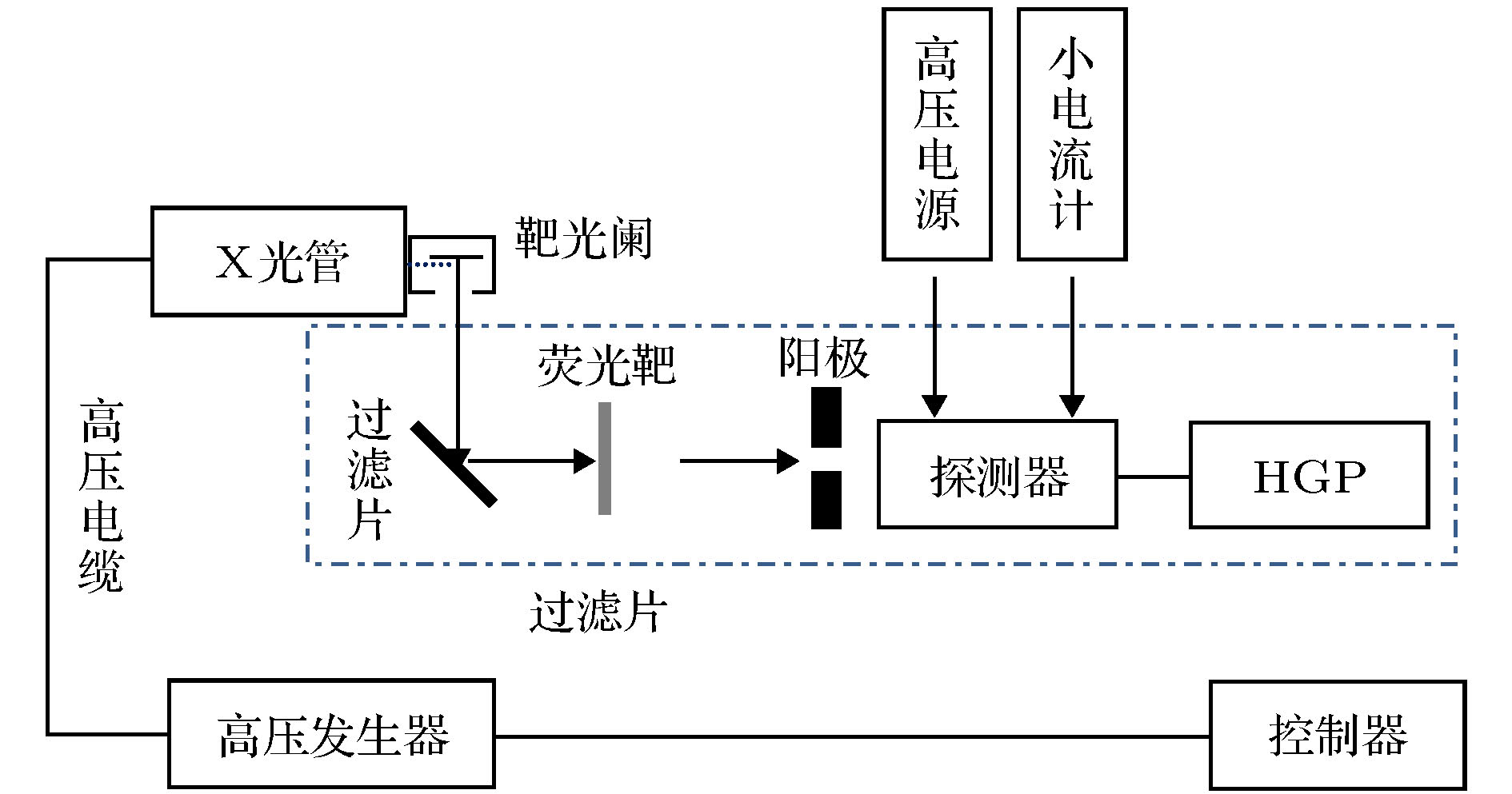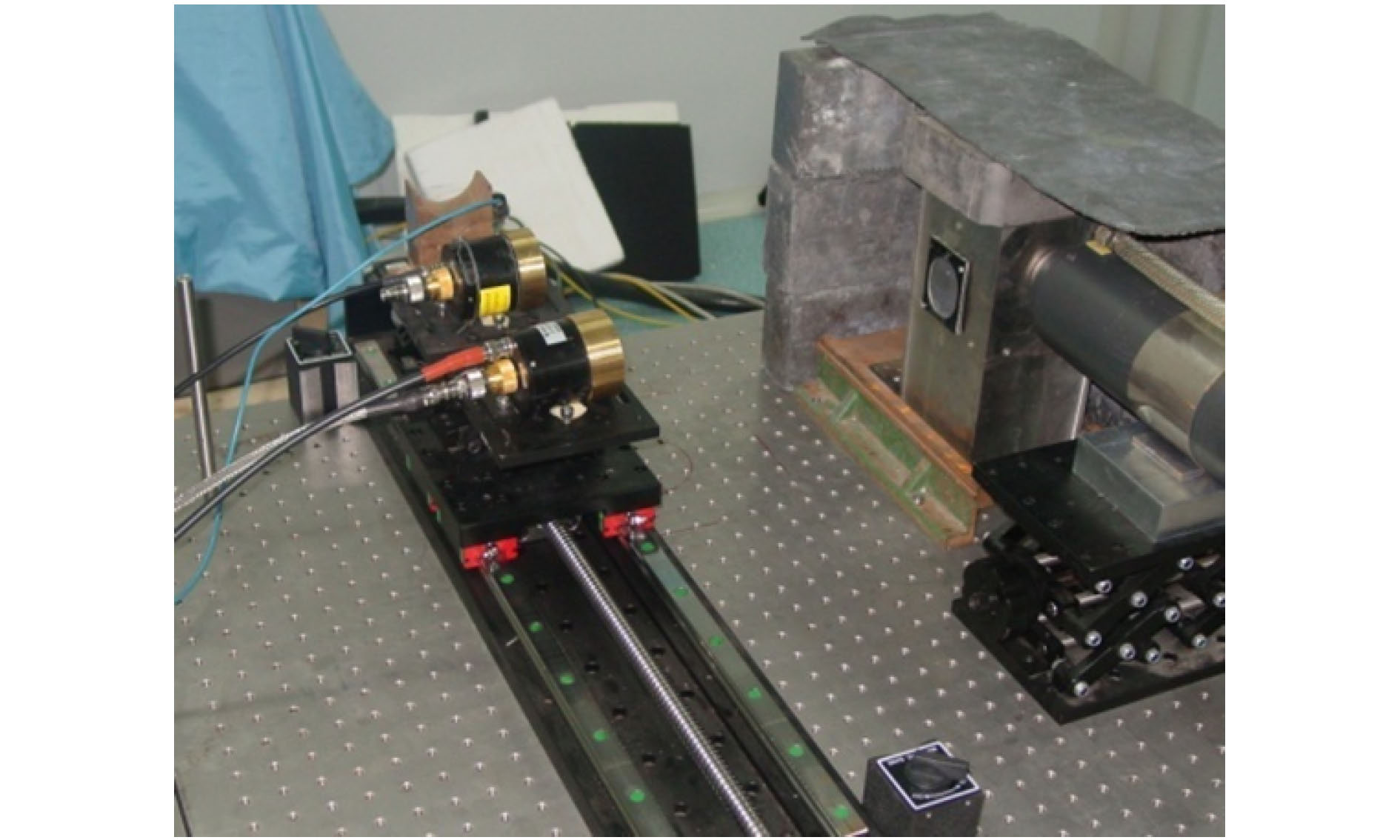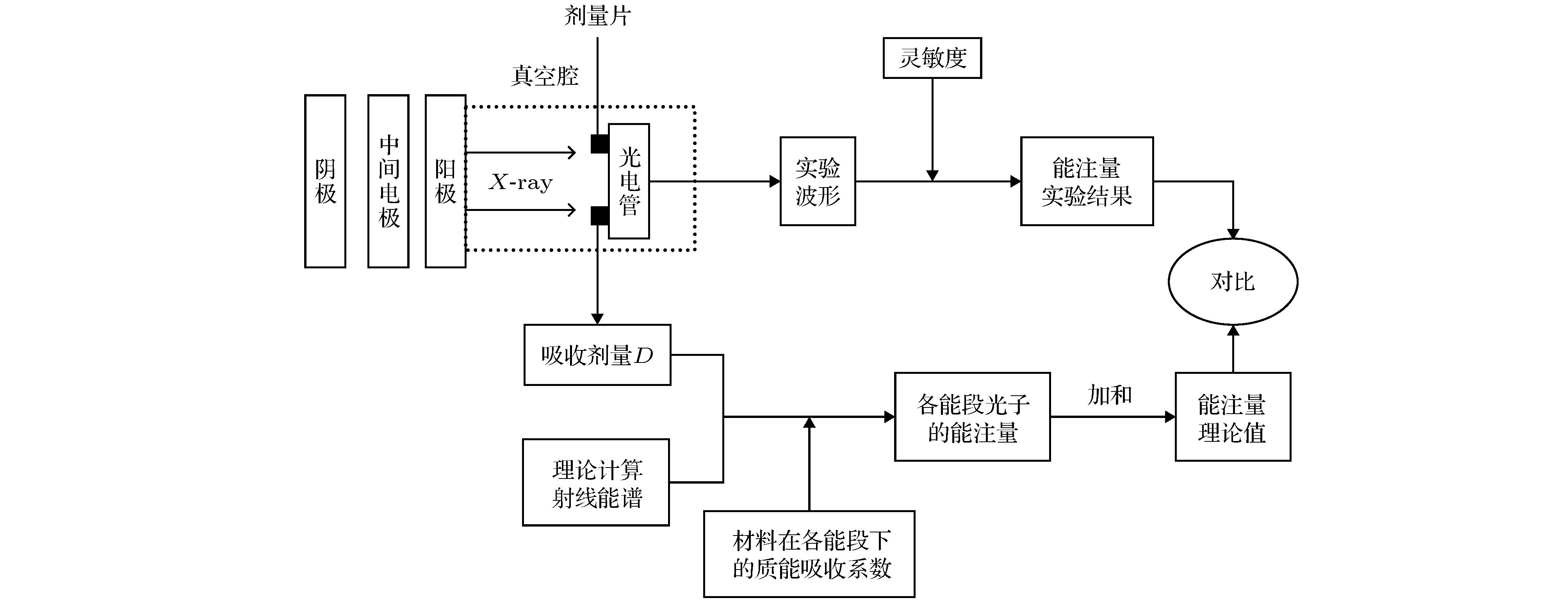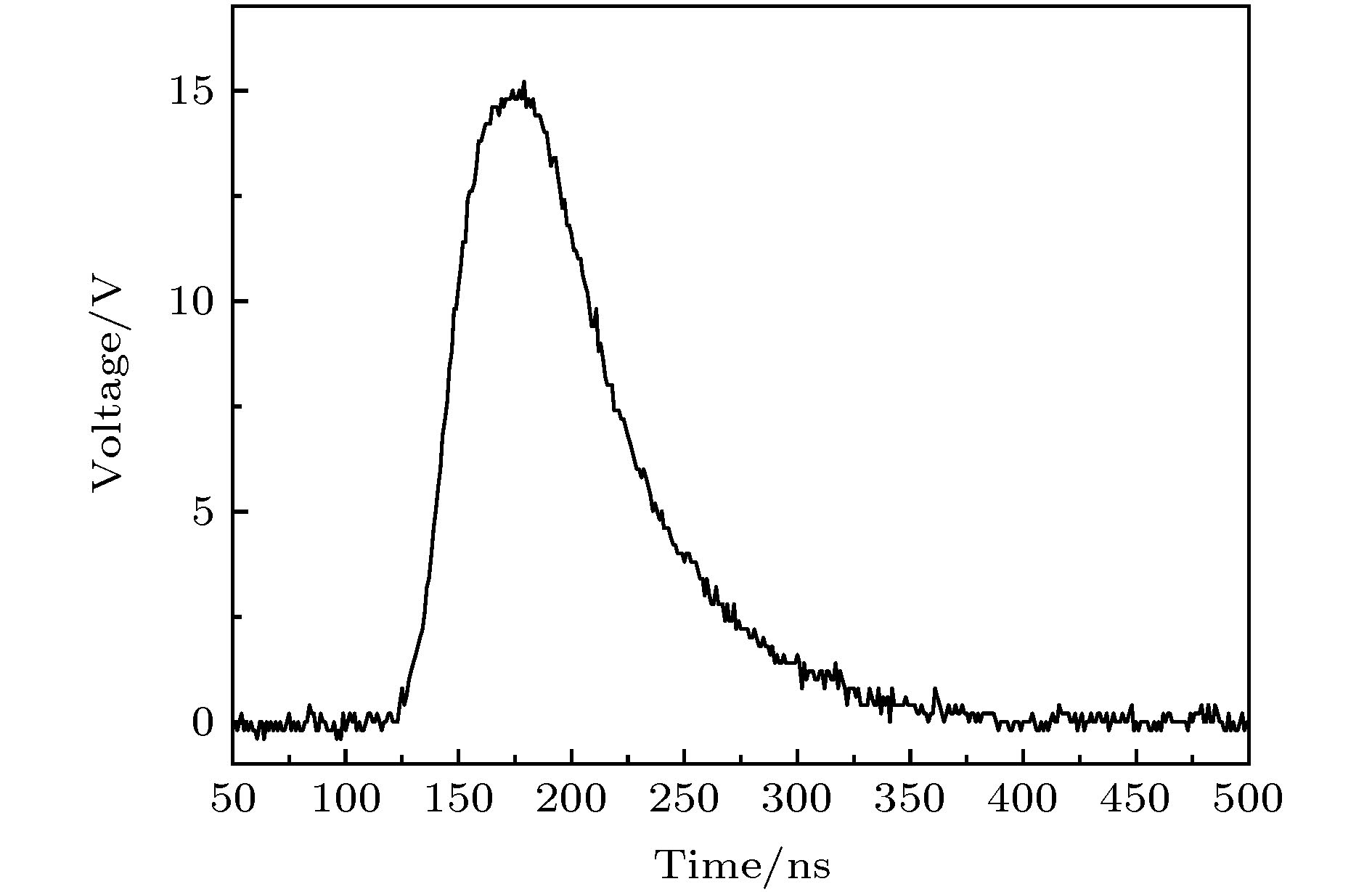-
Pulsed high-energy fluence X-ray source is based on the “Flash II” accelerator. It can be used to carry out effect vulnerability and sensitivity test of unit level system generated electromagnetic pulse (SGEMP). The energy fluence of pulsed hard X-ray is a main parameter of the equipment beam. At present, theoretical calculation method is widely used. Energy fluence can be calculated according to the dose, energy spectrum and energy absorption coefficient of each energy segment. The principle measuring energy fluence of pulsed hard X-ray by total absorption method is introduced. The photoelectric cell with lutetium silicate (LSO) scintillator is selected as a core component of the detection system, and the measurement system is developed. It is composed of scintillation detector, LSO scintillator, dimmer film, photon collimator, visible light shielding material, power supply and signal collecting system. The conversion coefficient between the incident photon energy and the waveform parameter is calibrated by a standard X-ray source. The energy fluence measurement experiment is carried out with the high-energy beam source of the “Flash II” accelerator as an experimental platform. In order to meet the requirements of the effect test experiments, the series diode structure is used in the accelerator for forming a high strength and large area uniform X-ray source. In the experiment, the LiF TLD is located in the front of the phototube and used to monitor the dose. According to the measured waveform, the actual energy of the incident photons is calculated. Combined with the receiving area of incident photons, the energy fluence of pulsed hard X-ray is calculated. The average measured value is 35.9 mJ/cm2 in 5 consecutive experiments. Energy fluence calculated from the measured dose and energy spectrum is 39.8 mJ/cm2. The results of the two methods are compared. It can be found that the experimental result is about 9.8% smaller than the theoretical value. The reasons are as follows. According to the law of exponential decay of rays in matter, in fact, the scintillator cannot absorb all the rays, and some of the rays can penetrate through, the energy of these rays cannot be detected, and thus giving rise to small experimental value. Due to the limited energy point of quasi-monoenergetic source, the sensitivity under the mean photon energy is taken as the sensitivity of the detector, and therefore there is a certain degree of uncertainty. The successful application of the measurement technology provides a good experimental method for the following similar research, and can also provide a reference for X-ray intensity analysis. [1] Failor B H, Coverdale C A 1999 Rev. Sci. Instrum. 70 569
 Google Scholar
Google Scholar
[2] 王雅琴, 胡广月, 赵斌, 郑坚 2017 物理学报 66 104202
 Google Scholar
Google Scholar
Wang Y Q, Hu G Y, Zhao B, Zheng J 2017 Acta Phys. Sin. 66 104202
 Google Scholar
Google Scholar
[3] 戚俊成, 叶琳琳, 陈荣昌, 谢红兰, 任玉琦, 杜国浩, 邓彪, 肖体乔 2014 物理学报 63 104202
 Google Scholar
Google Scholar
Qi J C, Ye L L, Chen R C, Xie H L, Ren Y Q, Du G H, Deng B, Xiao T Q 2014 Acta Phys. Sin. 63 104202
 Google Scholar
Google Scholar
[4] Hazelton R C, Yadlowsky E J, Moschella J J 2003 IEEE Trans. Plasma Sci. 31 1355
 Google Scholar
Google Scholar
[5] John E, R, Miriam G R, Arnold B 2003 Hard X-Ray and Gamma-Ray Detector Physics V. San Diego, California, USA, August 3, 2003 p334
[6] Meachum J S, Childers F K, Riordan J C 1991 Proceedings of the 8th IEEE International Pulsed Power Conf. San Diego, California, USA, June 16–19, 1991 p571
[7] Ware K D, Bell D E, Gullickson R L 2001 Proceedings of the 13th IEEE International Pulsed Power Conf. Las Vegas, Nevada, USA, June 17–22, 2001 p350
[8] Pellinen D, Ashby S, Gillis P, Nielsen K, Spence P 1979 Proceedings of the 2nd IEEE International Pulsed Power Conf. Lubbock, Texas, USA, June 12, 1979 p410
[9] 蒯斌, 邱爱慈, 王亮平, 林东生, 丛培天, 梁天学 2005 强激光与粒子束 17 1739
Kuai B, Qiu A C, Wang L P, Lin D S, Cong P T, Liang T X 2005 High Power Las. Part. Beam. 17 1739
[10] 李进玺, 吴伟, 来定国, 程引会, 马良, 赵墨, 郭景海, 周辉 2014 强激光与粒子束 26 035005
 Google Scholar
Google Scholar
Li J X, Wu W, Lai D G, Cheng Y H, Ma L, Zhao M, Guo J H, Zhou H 2014 High Power Las. Part. Beam. 26 035005
 Google Scholar
Google Scholar
[11] 汲长松 1990 核辐射探测器及其实验技术手册 (北京: 原子能出版社) 第61页
Ji C S 1990 Handbook of Nuclear Radiation Detectors and Their Experiment Techniques (Beijing: Atomic Energy Press) p61 (in Chinese)
[12] 苏兆锋, 来定国, 邱孟通, 任书庆, 徐启福, 杨实 2020 强激光与粒子束 32 035005
Su Z F, Lai D G, Qiu M T, Ren S Q, Xu Q F, Yang S 2020 High Power Las. Part. Beam. 32 035005
[13] Kirkby C J 2005 Ph. D. Dissertation (Canada: University of Alberta)
[14] Wesley P, Aparecido A C, Walter K S, et al. 2010 Instrum. Sci. Technol. 38 210
 Google Scholar
Google Scholar
[15] 张兴华, 赵宝升, 缪震华, 朱香平, 刘永安, 邹玮 2008 物理学报 57 4238
 Google Scholar
Google Scholar
Zhang X H, Zhao B S, Miao Z H, Zhu X P, Liu Y A, Zou W 2008 Acta Phys. Sin. 57 4238
 Google Scholar
Google Scholar
[16] 丁洪林 2010 核辐射探测器 (哈尔滨: 哈尔滨工业大学出版社) 第103页
Ding H L 2010 Nuclear Radiation Detectors (Harbin: Harbin Institute of Technology Press) p103 (in Chinese)
[17] Nitzan M, Mahler Y, Bodenheimer J S, Siew F P 1983 IEEE Trans. Biomed. Eng. BME-30 737
 Google Scholar
Google Scholar
[18] Horiai T, Kurosawa S, Murakami R, Yamaji A, Shoji Y, Ohashi Y, Pejchal J, Kamada K, Yokota Y, Yoshikawa A 2017 J. Cryst. Growth 468 391
 Google Scholar
Google Scholar
[19] 牛胜利, 雷林峰, 赵军, 张殿辉 2003 核电子学与探测技术 23 129
 Google Scholar
Google Scholar
Niu S L, Lei L F, Zhao J, Zhang D H 2003 Nucl. Electron. Detect. Technol. 23 129
 Google Scholar
Google Scholar
[20] 宋朝晖, 管兴胤, 代秋声, 王奎禄, 刘俊勇 2004 原子能科学技术 38 223
 Google Scholar
Google Scholar
Song C H, Guan X Y, Dai Q H, Wang K L, Liu J Y 2004 Atom. Energ. Sci. Technol. 38 223
 Google Scholar
Google Scholar
[21] 任国浩, 王绍华, 李焕英, 陆晟 2003 无机材料学报 18 269
 Google Scholar
Google Scholar
Ren G H, Wang S H, Li H Y, Lu S 2003 J. Inorg. Mater. 18 269
 Google Scholar
Google Scholar
[22] 周海洋, 朱晓东, 詹如娟 2010 物理学报 59 1620
 Google Scholar
Google Scholar
Zhou H Y, Zhu X D, Zhan R J 2010 Acta Phys. Sin. 59 1620
 Google Scholar
Google Scholar
[23] 张显鹏, 欧阳晓平, 张忠兵, 田耕, 陈彦丽, 李大海, 张小东 2008 物理学报 57 82
 Google Scholar
Google Scholar
Zhang X P, Ouyang X P, Zhang Z B, Tian G, Chen Y L, Li D H, Zhang X D 2008 Acta Phys. Sin. 57 82
 Google Scholar
Google Scholar
-
表 1 几种常见高密度闪烁体参数对比
Table 1. The parameter comparison of several common high density scintillators.
闪烁体 最强发射波长/nm 闪烁衰减时间/ns 折射率 密度/g·cm–3 相对光输出/% Bi4Ge3O12 480 300 2.15 7.13 12.0—14.0 BSO 480 2/30/100 2.06 6.80 2.0—5.0 LSO:Ce 420 40 1.82 7.40 75.0 PbWO4 480 10 2.16 8.20 0.5—1.0 GSO:Ce 450 31/65 1.90 6.71 20.0 ZnWO4 480 5000 2.20 7.87 26.0 CdWO4 540 5000 2.30 7.90 40.0 CaWO4 540 5000 2.30 7.90 40.0 表 2 入射光子透过不同厚度闪烁体的透射率
Table 2. The transmissivity of the photon transmitting scintillators of different thicknesses.
Thicknesses of scintillators /mm 0.01 10.00 15.00 20.00 25.00 30.00 35.00 Transmissivity/% 97.8200 1.9970 0.8750 0.4440 0.2270 0.1200 0.0695 表 3 探测器在不同能量下的灵敏度
Table 3. Sensitivity of the detector at different energies.
靶材 光谱仪电压/kV 光谱仪电流/mA X射线能量/keV 本底电流/nA 输出电流/nA 剂量率/mGy·s–1 灵敏度/10–17 C·cm2·MeV–1 Pb 100 25 75.0 3.9 24.2 8.78 5.29 W 95 30 59.2 2.2 11.9 3.25 6.79 Dy 75 35 46.0 3.7 29.4 50.77 3.87 Sn 50 60 25.3 3.9 26.7 55.77 3.13 表 4 连续5次实验的能注量测量结果
Table 4. Measurement results of energy fluence in five successive experiments.
发次 二极管电压/kV 二极管电流/kA 剂量/rad 能注量/mJ·cm–2 1 705 311 415.6 36.0 2 741 315 342.4 35.0 3 686 323 293.4 37.0 4 746 327 309.3 36.6 5 718 305 325.6 34.8 平均值 719.2 ± 25.0 316.2 ± 8.9 337.3 ± 47.4 35.9 ± 1.0 表 5 脉冲硬X射线能注量理论值
Table 5. Theoretial values of pulsed hard X-ray energy fluence.
能量/keV 15 30 60 90 120 150 能谱归一化数值 0.1174 0.2260 0.2110 0.1465 0.1104 0.0865 质能吸收系数/cm2·kg–1 9790 4080 143 69 69 69 能注量/ mJ·cm–2 0.04761 0.21996 5.85906 8.43404 6.35475 4.97756 能量/keV 180 210 300 400 500 600 能谱归一化数值 0.0533 0.0319 0.0103 0.0036 0.0021 0.0004 质能吸收系数/cm2·kg–1 29.1 29.1 29.1 29.1 29.1 29.1 能注量/ mJ·cm–2 7.27554 4.36081 1.41793 0.49708 0.29262 0.06403 -
[1] Failor B H, Coverdale C A 1999 Rev. Sci. Instrum. 70 569
 Google Scholar
Google Scholar
[2] 王雅琴, 胡广月, 赵斌, 郑坚 2017 物理学报 66 104202
 Google Scholar
Google Scholar
Wang Y Q, Hu G Y, Zhao B, Zheng J 2017 Acta Phys. Sin. 66 104202
 Google Scholar
Google Scholar
[3] 戚俊成, 叶琳琳, 陈荣昌, 谢红兰, 任玉琦, 杜国浩, 邓彪, 肖体乔 2014 物理学报 63 104202
 Google Scholar
Google Scholar
Qi J C, Ye L L, Chen R C, Xie H L, Ren Y Q, Du G H, Deng B, Xiao T Q 2014 Acta Phys. Sin. 63 104202
 Google Scholar
Google Scholar
[4] Hazelton R C, Yadlowsky E J, Moschella J J 2003 IEEE Trans. Plasma Sci. 31 1355
 Google Scholar
Google Scholar
[5] John E, R, Miriam G R, Arnold B 2003 Hard X-Ray and Gamma-Ray Detector Physics V. San Diego, California, USA, August 3, 2003 p334
[6] Meachum J S, Childers F K, Riordan J C 1991 Proceedings of the 8th IEEE International Pulsed Power Conf. San Diego, California, USA, June 16–19, 1991 p571
[7] Ware K D, Bell D E, Gullickson R L 2001 Proceedings of the 13th IEEE International Pulsed Power Conf. Las Vegas, Nevada, USA, June 17–22, 2001 p350
[8] Pellinen D, Ashby S, Gillis P, Nielsen K, Spence P 1979 Proceedings of the 2nd IEEE International Pulsed Power Conf. Lubbock, Texas, USA, June 12, 1979 p410
[9] 蒯斌, 邱爱慈, 王亮平, 林东生, 丛培天, 梁天学 2005 强激光与粒子束 17 1739
Kuai B, Qiu A C, Wang L P, Lin D S, Cong P T, Liang T X 2005 High Power Las. Part. Beam. 17 1739
[10] 李进玺, 吴伟, 来定国, 程引会, 马良, 赵墨, 郭景海, 周辉 2014 强激光与粒子束 26 035005
 Google Scholar
Google Scholar
Li J X, Wu W, Lai D G, Cheng Y H, Ma L, Zhao M, Guo J H, Zhou H 2014 High Power Las. Part. Beam. 26 035005
 Google Scholar
Google Scholar
[11] 汲长松 1990 核辐射探测器及其实验技术手册 (北京: 原子能出版社) 第61页
Ji C S 1990 Handbook of Nuclear Radiation Detectors and Their Experiment Techniques (Beijing: Atomic Energy Press) p61 (in Chinese)
[12] 苏兆锋, 来定国, 邱孟通, 任书庆, 徐启福, 杨实 2020 强激光与粒子束 32 035005
Su Z F, Lai D G, Qiu M T, Ren S Q, Xu Q F, Yang S 2020 High Power Las. Part. Beam. 32 035005
[13] Kirkby C J 2005 Ph. D. Dissertation (Canada: University of Alberta)
[14] Wesley P, Aparecido A C, Walter K S, et al. 2010 Instrum. Sci. Technol. 38 210
 Google Scholar
Google Scholar
[15] 张兴华, 赵宝升, 缪震华, 朱香平, 刘永安, 邹玮 2008 物理学报 57 4238
 Google Scholar
Google Scholar
Zhang X H, Zhao B S, Miao Z H, Zhu X P, Liu Y A, Zou W 2008 Acta Phys. Sin. 57 4238
 Google Scholar
Google Scholar
[16] 丁洪林 2010 核辐射探测器 (哈尔滨: 哈尔滨工业大学出版社) 第103页
Ding H L 2010 Nuclear Radiation Detectors (Harbin: Harbin Institute of Technology Press) p103 (in Chinese)
[17] Nitzan M, Mahler Y, Bodenheimer J S, Siew F P 1983 IEEE Trans. Biomed. Eng. BME-30 737
 Google Scholar
Google Scholar
[18] Horiai T, Kurosawa S, Murakami R, Yamaji A, Shoji Y, Ohashi Y, Pejchal J, Kamada K, Yokota Y, Yoshikawa A 2017 J. Cryst. Growth 468 391
 Google Scholar
Google Scholar
[19] 牛胜利, 雷林峰, 赵军, 张殿辉 2003 核电子学与探测技术 23 129
 Google Scholar
Google Scholar
Niu S L, Lei L F, Zhao J, Zhang D H 2003 Nucl. Electron. Detect. Technol. 23 129
 Google Scholar
Google Scholar
[20] 宋朝晖, 管兴胤, 代秋声, 王奎禄, 刘俊勇 2004 原子能科学技术 38 223
 Google Scholar
Google Scholar
Song C H, Guan X Y, Dai Q H, Wang K L, Liu J Y 2004 Atom. Energ. Sci. Technol. 38 223
 Google Scholar
Google Scholar
[21] 任国浩, 王绍华, 李焕英, 陆晟 2003 无机材料学报 18 269
 Google Scholar
Google Scholar
Ren G H, Wang S H, Li H Y, Lu S 2003 J. Inorg. Mater. 18 269
 Google Scholar
Google Scholar
[22] 周海洋, 朱晓东, 詹如娟 2010 物理学报 59 1620
 Google Scholar
Google Scholar
Zhou H Y, Zhu X D, Zhan R J 2010 Acta Phys. Sin. 59 1620
 Google Scholar
Google Scholar
[23] 张显鹏, 欧阳晓平, 张忠兵, 田耕, 陈彦丽, 李大海, 张小东 2008 物理学报 57 82
 Google Scholar
Google Scholar
Zhang X P, Ouyang X P, Zhang Z B, Tian G, Chen Y L, Li D H, Zhang X D 2008 Acta Phys. Sin. 57 82
 Google Scholar
Google Scholar
Catalog
Metrics
- Abstract views: 9011
- PDF Downloads: 73
- Cited By: 0















 DownLoad:
DownLoad:




